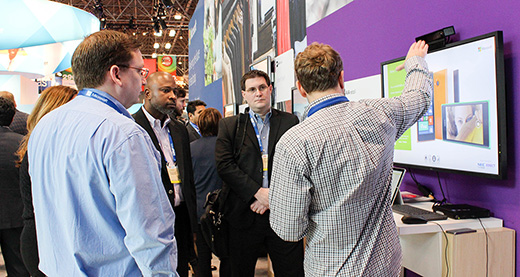Kinect-enabled solutions offer insights on retail customers
If you wanted to see the latest, most innovative technology for retailers, the 2015 National Retail Federation (NRF) Expo was the place to be. This annual event, popularly known as the “Big Show,” took place January 11–13 in New York City. For the third consecutive year, the Kinect for Windows team was pleased to participate in the Microsoft booth, along with our colleagues from the Microsoft Retail Industry team.

At the Microsoft booth, Justin Miller from NEC demoed their digital signage solution, which combines
Kinect v2 depth tracking with NEC's demographic and facial recognition software.
It has been exciting to see the changes that have taken place with Kinect in retail, particularly in the area of shopper analytics. At the 2013 and 2014 NRF events, interest in Kinect focused on the sensor’s unique capability to enable touchless interactions with large-screen displays. So we saw Kinect used to create innovative, interactive digital signs and kiosks, and even virtual fitting rooms. While those scenarios continue to offer compelling enhancements to the shopping experience, more and more developers are recognizing the potential of Kinect in collecting and analyzing shopper behavior, as demonstrated by the Kinect-enabled solutions from AVA retail and NEC that were on display in the Microsoft booth.
AVA retail demoed two fascinating products: Path Tracker and SmartShelf.
- Path Tracker was powered by six Kinect v2 sensors mounted some 30 feet (about 9 meters) above our booth, providing complete coverage of the exhibit floor. The sensors offered real-time detection and analysis of the path of every visitor to the Microsoft booth, thus demonstrating how a retailer could determine shoppers’ paths in the store. By showing the areas visited and how much time visitors spent there, it demonstrated how it could provide retailers with shopper counts and a heat map of where in the store their customers spend the most time.
- Unlike the panoramic views employed by Path Tracker, SmartShelf focused on a particular retail shelf. By using the high-fidelity depth-sensing capabilities of a downward-facing Kinect sensor to monitor every customer interaction with products on that shelf, it provided real-time data on which products customers picked up and how long they were held. In addition, SmartShelf triggered digital signage that provided details and marketing materials for the products selected, and it sent mobile alerts to the tablet PCs of the sales staff (in this case, the booth personnel), letting them know, in real time, which products the customers were viewing.
NEC Enterprise Biometrics also had an exciting demo in our booth: a unique digital signage solution that combined Kinect v2 depth tracking with NEC’s demographic and facial recognition software. It works like this: the Kinect sensor detects a shopper’s proximity to and engagement with digital signage in a product endcap or kiosk, launching an attract screen if the shopper appears to being walking away from the display. When a shopper stops and approaches the screen, a loop of product marketing messages begins to play. At this point, the Kinect sensor forwards data on the shopper’s face to the NEC biometric software, which determines the gender and approximate age of the customer, using this information to serve up age- or gender-appropriate product recommendations. While these targeted product recommendations are important for driving sales, the NEC solution is equally—if not more—valuable for the data analytics it provides, as it tracks the estimated age and gender of all the shoppers who walk by the kiosk, not just those who stop to engage. (It also recognizes store employees and does not include their data.) It also tracks the effectiveness of the messaging throughout the attraction, engagement, and purchase stages, to determine if the display is connecting with the target demographic for that particular product.
As these innovative demos show, Kinect-based solutions can offer brick-and-mortar retailers the kinds of customer analytics and insights that their online counterparts take for granted. It’s going to be an exciting year!
Michael Fry, Business Development and Partner, Kinect for Windows
Key links